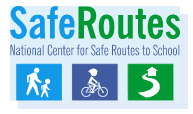Safe Routes to School (SRTS) is an international movement that has been implemented in communities throughout the United States. The concept is to increase the number of children who walk or bike to school safely by funding projects that resolve barriers to walking, such as poor walkways, limited adult supervision or crime. These programs also encourage walking and biking to school as a way to incorporate a healthy, active lifestyle into a daily routine.
The components of a SRTS program use a public health model of health promotion, commonly referred to as the five E’s:
- Evaluation
- Education
- Encouragement
- Enforcement
- Engineering
The program begins with an evaluation of the current situation at the school by surveying the parents and students on their concerns and motivations, conducting focus groups to drill down to specific issues and conducting a tally of the number of students who walk or bike to school. Working with City engineers, local police, school administrators, parents, and students on conducting a “walk audit” of the school perimeter.
In this walk audit, each team member cites concerns such as poor signage and walkways, traffic issues and current walking behaviors (view the video below to get more information on walk audits). From this evaluation, engineering begins to work on structural issues and signage, police begin to work on enforcement of specific traffic and pedestrian patterns, and the school develops a safety patrol to address issues on the school campus.
As part of this evaluation, the team also identifies what will motivate students to walk or bike to school and begins programming in education and encouragement. Schools can choose various educational presentations from a menu of services so that each program is tailored to their specific needs. To encourage students to walk or bike to school each school participates in the Active-4-me program. This program registers students, and provides a scan card, which tallies how many times they walk or bike to school, how many miles they have walked, how much carbon emissions have been spared and how many gallons of gas have been saved.
This information is also used in the educational curriculum and incorporated in math classes, environmental science, social studies and English classes to link the benefits of a active lifestyle to many aspects of their educational experience. At the conclusion of the three-year program, evaluation is again conducted to assess if changes have been made and provide recommendations to the school and community for sustaining the positive changes developed during the course of the program.
Resources
Safety Tips & Activities
